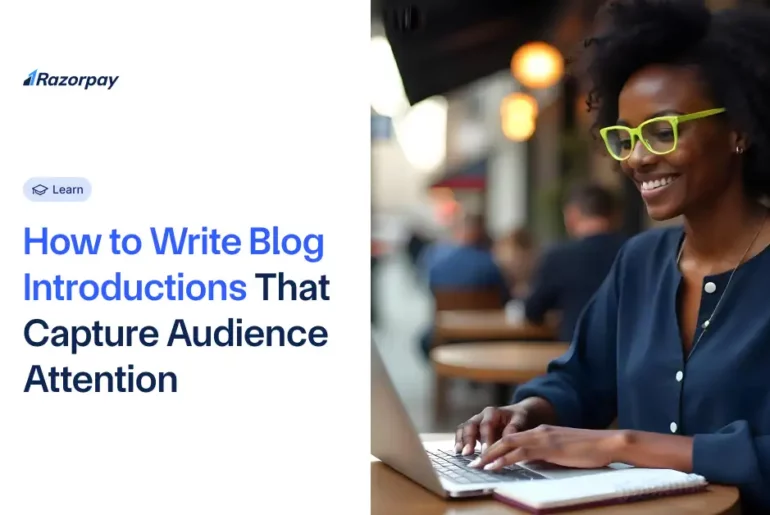Blogging is a powerful tool to share your ideas, experiences, and expertise with the world. Whether you’re a business owner looking to attract more customers, a passionate hobbyist eager to connect with like-minded individuals, or simply someone with a story to tell, how to write a blog post that engages and informs your audience is a skill worth mastering.
However, the process of creating a compelling blog post can seem daunting, especially for beginners. From choosing a topic to promoting your published piece, there are numerous steps involved in crafting content that resonates with readers and ranks well in search engines.
In this comprehensive guide, we’ll walk you through a proven 9-step process for how to write a blog post, complete with free templates to streamline your writing. By the end, you’ll have a clear roadmap for consistently producing high-quality blog posts that drive traffic, build authority, and foster a loyal following.
Table of Contents
What is a Blog Post?
Before we explore how I write a blog post, let’s clarify what a blog post is. A blog post is a piece of content published on a blog, typically addressing a specific topic or telling a story. Blog posts can cover various subjects, from personal experiences to industry insights, and are usually written in a conversational style to engage readers.
Blog posts serve several purposes:
• Sharing information, opinions, or advice
• Entertaining or inspiring readers
• Driving traffic to a website
• Establishing authority in a niche
• Promoting products or services
Unlike static website pages, blog posts are dynamic and frequently updated. They often allow readers to leave comments and interact with the author. When considering how to write a blog post for beginners, remember that your primary goal is to provide value to your target audience.
How to Write a Blog Post in 9-Steps
Now that you understand what a blog post is, let’s break down the process of how to write a great blog post into 9 manageable steps. Following this blueprint will ensure your posts are well-structured, engaging, and optimised for search engines.
Step 1: Start with a proven topic
The first step in how to write a blog post for beginners is choosing a topic that aligns with your audience’s interests and your blogging goals. Here are some strategies for finding proven topics:
-
Conduct market research to identify your target audience’s pain points, questions, and content preferences
-
Use keyword research tools to discover high-volume, low-competition search terms related to your niche
-
Analyse your competitors’ top-performing posts to find topic ideas that have already resonated with readers
-
Monitor social media and online forums to spot trending topics and conversations in your industry
Once you have a list of potential topics, narrow it down to one specific angle you can cover in depth. For example, instead of a generic post on “Email marketing“, you might write about “9 Proven Email marketing Strategies to Double Your Open Rates”. By selecting a topic with proven demand, you’ll be more likely to attract readers and generate engagement.
Step 2: Choose the angle for your post
Once you’ve identified a general topic, it’s time to narrow your focus and choose a specific angle. Consider these approaches:
-
Address a specific question or problem your target audience faces
-
Provide a step-by-step tutorial or how-to guide
-
Share insights from your personal experience or case studies
-
Offer a fresh perspective on a well-covered topic
-
Curate expert tips or resources on a particular theme
The key is to find an angle that sets your post apart and provides unique value to your readers. For instance, a step-by-step tutorial might work well for a DIY home improvement blog, while an opinionated think piece could fit a political commentary site.
Step 3. Create an outline
With your topic and angle in mind, create an outline to organize your ideas and ensure your post flows logically. A typical blog post outline includes:
-
Introduction: Capture readers’ attention and preview the post’s main points
-
Main Body: Break down your topic into subheadings, each covering a specific aspect or step
-
Conclusion: Recap your key takeaways and provide a call to action
A. Share your personal experiences and insights
Injecting your unique voice and perspective can make your post more engaging and authentic. Consider sharing:
-
Lessons you’ve learned in your niche
-
Challenges you’ve overcome
-
Results you’ve achieved using the strategies you’re teaching
B. Conduct a content gap analysis
To make your post as comprehensive as possible, identify gaps in existing content on your topic. Look for:
-
Questions left unanswered by other posts
-
Steps or details other articles gloss over
-
Unique tips or techniques not commonly shared
By filling these gaps, you’ll create a more valuable resource for readers.
Step 4. Write your first draft
With your outline as a roadmap, it’s time to flesh out your post. The key to this step is to focus on getting your ideas down on paper without worrying too much about perfection. Remember, you’ll have the opportunity to refine and polish your work in the editing stage.
As you write, keep the following tips in mind
-
Write an attention-grabbing intro that hooks readers and establishes your post’s value
-
Use short paragraphs and simple language to keep readers engaged
-
Incorporate storytelling to illustrate your points and create an emotional connection
-
Include relevant images, videos, infographics, or screenshots every 300-400 words to add visual interest and reinforce your message.
-
Back up claims with research, data, and examples
-
Optimise for search engines by naturally incorporating relevant keywords and phrases
-
End your post with a clear call-to-action that encourages readers to implement your advice, leave a comment, share the post, or take another desired action.
Remember, your first draft is just a starting point. The goal at this stage is simply to get your ideas out of your head and onto the page. You’ll refine your post in the next step.
Step 5: Edit and refine your draft
Once you have a complete first draft, it’s time to polish your post. Read through your content with a critical eye.
-
When editing your blog post, focus on the following areas:
-
Clarity and concision: Eliminate any jargon, fluff, or redundancies that don’t add value. Aim for clear, concise language that gets your point across efficiently.
-
Structure and flow: Ensure each paragraph and section logically flows into the next. Use transitional phrases to improve coherence and guide readers through your post.
-
Grammar and spelling: Run your post through a tool like Grammarly to catch any grammatical errors or typos. Reading it out loud can also help you identify awkward phrasing.
-
Formatting and readability: Break up long paragraphs, add bullet points where appropriate, and ensure your subheadings are descriptive and engaging. Optimize your title tag, meta description, URL, and image alt text for search engines.
-
Fact-checking and citing sources: Double-check any factual claims against reputable sources. Cite data, quotes, and examples with links to the original material.
-
Adherence to your outline: Refer back to your initial outline to ensure you’ve covered all your planned points and haven’t gone off-topic. Cut any tangents that don’t serve your core message.
The editing process is all about moulding your raw ideas into a polished, publishable piece. Consider asking a colleague or friend to review your post and provide feedback. A fresh set of eyes can help you catch issues you may have missed.
-
Step 6. Create a catchy headline
Your headline is often the first (and sometimes only) thing readers see. A compelling headline can mean the difference between someone clicking through to your post or scrolling past it. When crafting your headline, aim to:
-
Communicate your post’s key benefit or takeaway
-
Spark curiosity or emotion in readers
-
Incorporate relevant keywords for SEO
-
Keep it concise – aim for around 60 characters or less
-
Test different variations to see what performs best
Some effective headline formulas include:
-
“Numbers + Adjective + Keyword + Promise (e.g., “9 Simple Tips to Boost Your Niche Marketing Results”)
-
How to + Desired Outcome (e.g., “How to How To Make A WordPress Website in 5 Easy Steps”)
-
The Ultimate Guide to + Topic (e.g., “The Ultimate Guide to Mastering Market Research”)
-
Attention-Grabbing Adjective + Keyword (e.g., “Little-Known Strategies for Effective Email Marketing”)
-
Keyword + Without + Undesirable Outcome (e.g., “market research Without Breaking the Bank”)
Your headline should make a promise to readers about what they’ll gain from your post. Make sure your content delivers on that promise.
Step 7. Add images and visual elements
Visual content is a powerful way to break up text, illustrate concepts, and make your post more engaging.
Here are some ways to incorporate visuals into your blog post:
-
Use high-quality, relevant images that support your points
-
Include infographics to present data or explain complex topics
-
Embed videos or GIFs to illustrate processes or entertain readers
-
Create custom graphics using tools like Canva or Venngage
-
Use screenshots to provide step-by-step tutorials
-
Add charts and graphs to visualise statistics and trends.
When adding images, be sure to:
-
Use high-quality visuals that look professional
-
Include descriptive alt text for each image
-
Compress images to ensure fast loading times
-
Provide proper attribution if using third-party visuals
Step 8. Publish your post
Once you’ve completed your edits and added visual elements, it’s time to hit publish. Before you do, be sure to:
-
Preview your post to check for any formatting issues
-
Ensure your post is mobile-friendly
-
Craft a compelling meta description to entice searchers to click through
-
Double check that your post is properly categorised and tagged
-
Schedule your post for the optimal day and time for your audience
When selecting a publishing platform, consider factors like ease of use, customization options, and built-in SEO tools. Popular choices include WordPress, Squarespace, and Wix. If you’re new to blogging, our guide on How To Make A WordPress Website can help you get started. After publishing, be sure to monitor your post’s performance. Check your analytics to see which topics and formats resonate most with readers.
Step 9. Promote your blog post
Creating a great post is only half the battle. To drive traffic and engagement, you also need to actively promote your content. Some effective promotion strategies include:
-
By sharing your post on your social media profiles, including LinkedIn, Twitter, Facebook, and Instagram. Use relevant hashtags and tag any individuals or brands mentioned in your post to increase its reach.
-
Sending your post to your email list
-
Reaching out to other bloggers or publications for backlinks
-
Repurposing your post into other formats like infographics or videos to share on different platforms
-
Running paid ads to your post on social media or search engines
-
Share your post on relevant online forums, Facebook groups, or Reddit threads where your target audience is active.
Promoting your blog posts should be an ongoing effort, not a one-and-done task. Keep sharing your evergreen content on a regular basis and look for new opportunities to get it in front of fresh eyes. The more eyeballs you can get on your post, the more impact it will have. Keep testing different promotion tactics to see what works best for your audience.
What Makes a Blog Post-Great?
A great blog post is more than just a collection of words on a screen. It’s a purposeful piece of content that educates, entertains, or inspires its target audience. Here are some key characteristics of outstanding blog posts:
1. Relevant and valuable topic:
The best blog posts address the pain points, interests, and questions of their intended readers. They provide original insights, actionable advice, or thought-provoking perspectives that leave a lasting impact.
2. Engaging introduction:
A compelling opening hooks readers from the very first sentence. It could be a surprising statistic, a relatable anecdote, or a thought-provoking question that entices them to keep reading.
3. Clear structure and flow:
Great blog posts are well-organised namaste and easy to follow. They use headings, subheadings, bullet points, and short paragraphs to break up the text and guide readers through the content.
4. Comprehensive and in-depth coverage:
Rather than scratching the surface, the best blog posts dive deep into their chosen topic. They provide thorough explanations, real-life examples, data-driven insights, and practical tips that fully satisfy the reader’s curiosity.
5. Engaging and conversational tone:
Great blog posts read like a conversation with a knowledgeable friend. They use simple language, personal pronouns, and a touch of humour to build rapport and keep readers engaged.
6. Visually appealing formatting
Attractive images, videos, infographics, and other visual elements enhance the reading experience and reinforce key points. Ample white space and a clean layout make the post inviting and easy to scan.
7. Optimised for search engines
Well-crafted blog posts are optimised for SEO best practices, including targeted keywords, meta descriptions, alt tags, and internal linking. This helps them rank higher in search results and attract organic traffic.
8. Strong call-to-action:
The best blog posts encourage readers to take a specific action, such as leaving a comment, sharing the post on social media, signing up for a newsletter, or Niche marketing their offerings. A clear CTA turns casual readers into engaged followers.
By incorporating these qualities into your own blog posts, you’ll be well on your way to creating content that resonates with readers and drives real results for your blog.
6. Free Blog Post Templates
To streamline your writing process and ensure you’re covering all the essential elements, consider using a blog post template. Here are 6 free templates for common blog post types:
1. How-To Posts
How-to posts walk readers through a specific process or task. They’re an effective way to teach readers a new skill or help them solve a problem. A typical how-to post template includes:
-
Introduction: Explain what the post will cover and why it matters to readers
-
Materials/Prerequisites: List any tools, materials, or prior knowledge needed
-
Step 1: Break down the first step in the process
-
Step 2: Explain the next step
-
[Additional Steps]: Continue outlining each step until the process is complete
-
Conclusion: Recap the key steps and the end result readers can expect
-
FAQs: Address common questions or concerns readers may have
2. What is Posts
What is posts simplifies complex topics, providing clear explanations that engage readers and improve understanding. It’s ideal for establishing authority and driving traffic through concise, valuable content.
-
Title: What Is [Topic]?
-
Introduction: Briefly introduce the topic and why it’s important.
-
Definition: Provide a clear, simple explanation of the topic.
-
Key Points: Highlight 2-3 main features, benefits, or applications.
-
Conclusion: Summarise the key takeaway and encourage further exploration.
3. List-Based Posts
List-based posts break down a topic into a numbered list of tips, examples, or resources. They’re a scannable, shareable format that works well for almost any topic. A list-based post template might look like:
-
Introduction: Preview what the list will cover and why it’s valuable to readers
-
List Item 1: Explain the first item on your list in detail
-
List Item 2: Move on to the second item
-
[Additional List Items]: Continue through all the items on your list
-
Conclusion: Recap the key takeaways and provide a call to action for readers
4. Pillar Page Posts
Pillar page posts provide a comprehensive overview of a broad topic, linking out to more detailed posts on each subtopic. They’re an effective way to showcase your blog’s depth of content and improve your site architecture for SEO. A pillar page template might include:
-
Introduction: Explain the broad topic the pillar page will cover and why it’s important
-
Subtopic 1: Provide a brief overview of the first subtopic and link to a more detailed post
-
Subtopic 2: Move on to the next subtopic
-
[Additional Subtopics]: Continue covering each subtopic you want to include
-
Conclusion: Recap the key themes and encourage readers to explore the linked resources
5. Newsjacking Posts
Newsjacking posts capitalise on a current event or trending topic in your industry. They allow you to join a larger conversation and showcase your brand’s unique perspective. A newsjacking post template includes:
-
Introduction: Summarise the news story or trend and explain why it matters to your audience
-
Your Take: Share your unique angle or perspective on the topic
-
Implications: Explain how this news affects your industry or audience
-
Action Items: Provide concrete next steps or recommendations for readers
-
Conclusion: Recap your key points and tie the story back to your brand’s mission or values
6. Infographic Posts
Infographic posts translate data or complex topics into engaging visual content. They’re highly shareable and can help you reach a wider audience. An infographic post template includes:
-
Introduction: Explain what the infographic will cover and why it’s valuable to readers
-
Embed Infographic: Insert your infographic image
-
Key Takeaways: Break down the main points illustrated in the infographic
-
Conclusion: Encourage readers to share the infographic and link to additional resources on the topic
Conclusion
Learning how to write and post a blog requires practice and persistence, but by following a clear process and focusing on providing value to your audience, you can create compelling posts that drive results. The key steps include choosing a proven topic, selecting a unique angle, creating an outline, drafting your post, editing and refining, crafting a compelling headline, adding visual elements, and publishing and promoting your post. By applying these steps and leveraging the tips and templates provided in this guide, you’ll be well-equipped to craft content that resonates with readers and helps achieve your blogging goals.
Frequently Asked Questions (FAQs)
1. What is a blog post example?
A blog post example is a published article on a blog that demonstrates how to write a good blog post. It typically covers a specific topic in detail and includes elements like an introduction, subheadings, examples, and a conclusion. Popular blog post examples include how-to guides, list-based posts, and opinion pieces.
2. What is a blog post format?
A blog post format is the structure and layout of a blog post. A typical blog post format includes a compelling headline, an introduction that hooks the reader and sets the stage for the rest of the post, several body paragraphs that explore the main points or arguments, and a conclusion that summarises the key takeaways and encourages the reader to take action. Other common elements of a blog post format include subheadings, bullet points, images, and a call-to-action.
3. What are the five steps to writing a blog post?
The five main steps to writing a blog post are:
-
Planning: Choose a topic, conduct research, and create an outline.
-
Writing: Craft a compelling introduction, develop your main points in the body paragraphs, and write a strong conclusion.
-
Editing: Revise and refine your post for clarity, conciseness, and flow.
-
Formatting: Add subheadings, bullet points, images, and other visual elements to make your post more engaging and easier to read.
-
Promoting: Share your post on social media, reach out to other bloggers and influencers, and optimise for search engines to drive traffic and engagement.
By following these five steps and continually refining your skills through practice and experimentation, you’ll be well on your way to How to write a blog post for beginners that truly resonates with your audience and helps you achieve your blogging goals.





